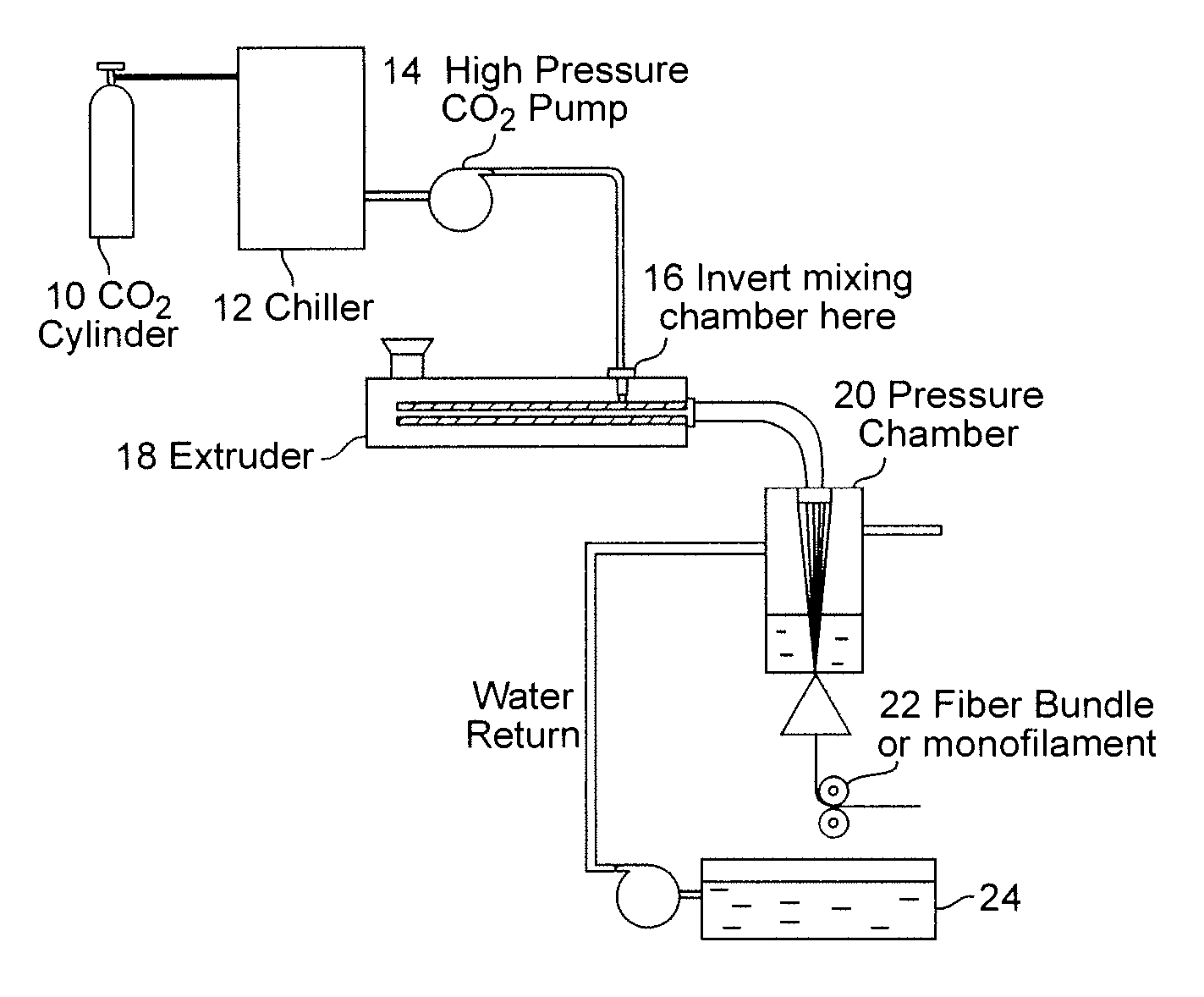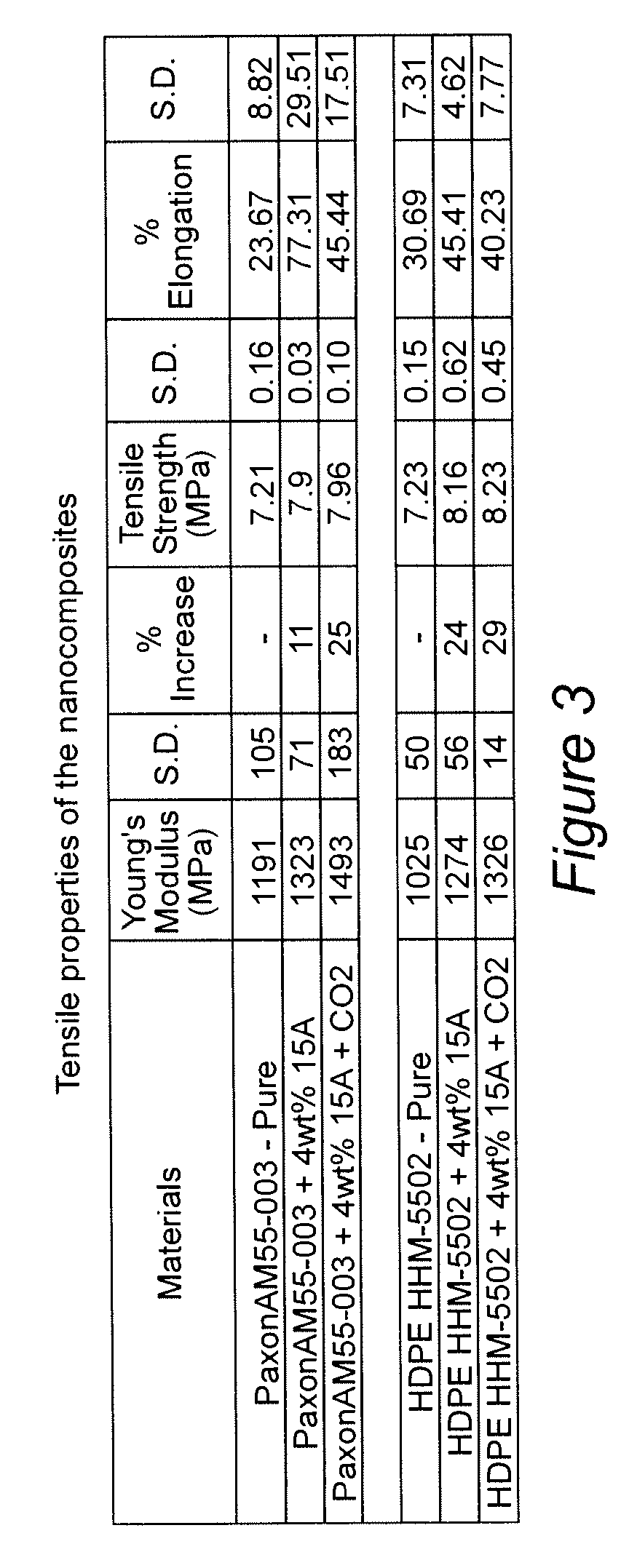Process for increasing the exfoliation and dispersion of nanoparticles into polymeric matrices using supercritical carbon dioxide
a technology of supercritical carbon dioxide and nanoparticles, which is applied in the direction of bulk chemical production, etc., can solve the problems of inability to achieve loading levels inability to provide any mechanism for ensuring, and inability to achieve loading levels of greater than 4 wt % by prior methodologies. achieve the effect of high level of exfoliated nano-clays, improve mechanical, barrier and electrical properties
- Summary
- Abstract
- Description
- Claims
- Application Information
AI Technical Summary
Benefits of technology
Problems solved by technology
Method used
Image
Examples
example 1
[0026] This is Example is similar to the techniques discussed in U.S. Pat. No. 6,753,360 to Mielewski where nano-clays are combined with polymer and melt blended. Subsequently, supercritical carbon dioxide was injected. This procedure provides some benefits, but not nearly as much as is provided by the process set forth in Example 2 where the supercritical carbon dioxide directly contacts the nano-clay, absorbs into the galleries, and the pressure is then released rapidly (drop from 3000 psi to 1000 psi in 5 seconds or less), the clay is separated and exploded, and then the misutre is injected into the extruder where it is mixed with the polymer melt.
[0027] Materials. High-density polyethylene (HDPE) HHM-5502 resin with Mw=45,000 g / mol and Mw / Mn=3.0 and HDPE PaxonAM55-003 resin were provided from Chevron Phillips Chemical Company and P&G, respectively, and were used as received. Surface modified montmorillonite (Cloisite 15A) was obtained from Southern Clay Products, Inc. Cloisite ...
example 2
[0034] The pressurized chamber of FIG. 2 was applied to the preparation of the polypropylene / 20A nanocomposites. This chamber was inserted between the CO2 pump and the injection port at the beginning of the second stage of the screw as shown by the arrow in FIG. 1. The clays were allowed to be in direct contact with sc CO2 at 2500 psi and 80° C. for a period of time and then were rapidly released. The mixture of the nano-particles and sc-CO2 were then injected into the molten polymer stream in a single screw extruder. The produced extrudates were pelletized and then injection molded into plaques using an Arburg Allrounder Model 221-55-250 molding unit for further characterization.
[0035] WAXD patterns for pristine organoclay 20A powder, commercial RTP PP-4 wt % clay nanocomposites, and PP6523 / clay nanocomposites prepared via direct melt compounding and using the new pressurized chamber are shown in FIG. 6. The clay concentration on the composites produced via direct melt compounding...
PUM
| Property | Measurement | Unit |
|---|---|---|
| Pressure | aaaaa | aaaaa |
| Dispersion potential | aaaaa | aaaaa |
| Viscosity | aaaaa | aaaaa |
Abstract
Description
Claims
Application Information
 Login to View More
Login to View More - R&D
- Intellectual Property
- Life Sciences
- Materials
- Tech Scout
- Unparalleled Data Quality
- Higher Quality Content
- 60% Fewer Hallucinations
Browse by: Latest US Patents, China's latest patents, Technical Efficacy Thesaurus, Application Domain, Technology Topic, Popular Technical Reports.
© 2025 PatSnap. All rights reserved.Legal|Privacy policy|Modern Slavery Act Transparency Statement|Sitemap|About US| Contact US: help@patsnap.com



